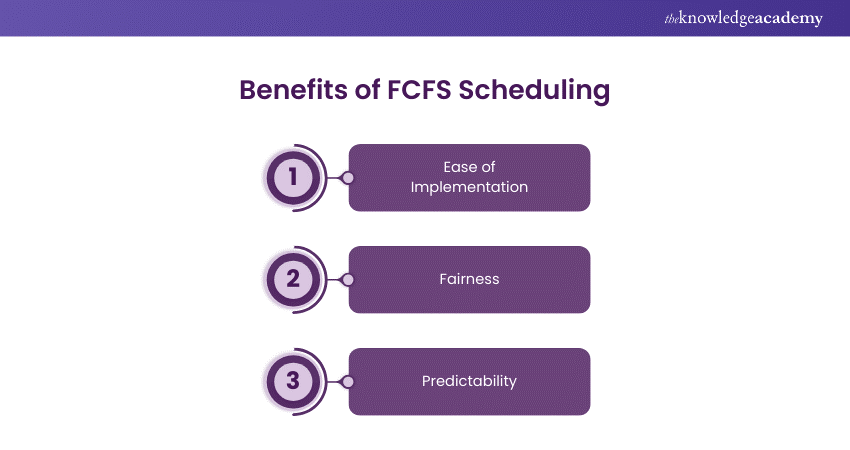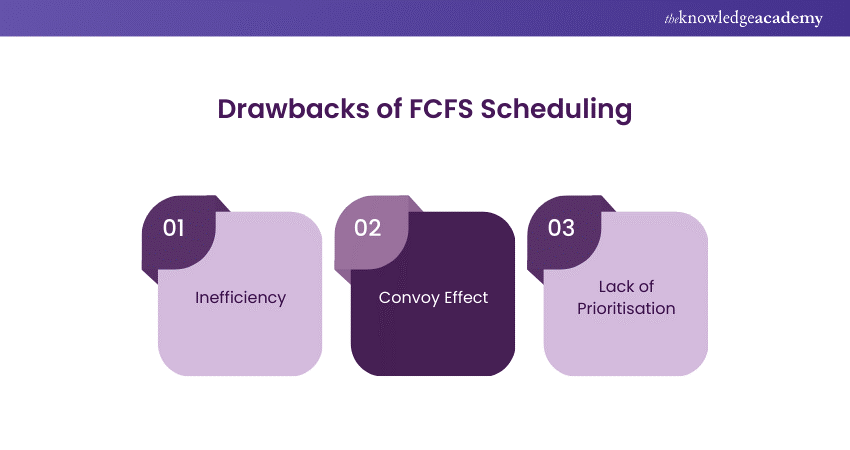We may not have the course you’re looking for. If you enquire or give us a call on +1 7204454674 and speak to our training experts, we may still be able to help with your training requirements.
Training Outcomes Within Your Budget!
We ensure quality, budget-alignment, and timely delivery by our expert instructors.

Imagine securing a table at a popular restaurant without hours of online waiting. This is the efficiency that First Come First Serve (FCFS) scheduling aims to replicate in computer systems. Understanding how this fundamental algorithm works is crucial for optimising system performance and resource allocation.
This blog will delve into the intricacies of First Come First Serve scheduling, its applications, and its impact on various computing processes. Join us as we uncover how this algorithm shapes the operation of our computers and systems.
Table of Contents
1) What is First Come First Serve?
2) How a FCFS Scheduling Algorithm Works?
3) Types of FCFS Scheduling
4) Algorithm for FCFS Scheduling
5) Characteristics of FCFS Scheduling
6) Benefits of FCFS Scheduling
7) Drawbacks of FCFS Scheduling
8) First Come First Serve Examples with Solutions
9) Conclusion
What is First Come First Serve?
First Come First Serve (FCFS) is one of the simplest and most straightforward scheduling algorithms used in various fields, including computer science, operations management, and logistics. The principle behind FCFS is exactly as it sounds; tasks are processed in the order they arrive, without prioritisation. This method is akin to standing in a queue at a supermarket checkout; the first person in line is the first to be served.
How a FCFS Scheduling Algorithm Works?
The FCFS scheduling algorithm operates on a straightforward principle: the first task to arrive is the first to be executed. This method does not pre-empt tasks, meaning once a task starts, it runs to completion before the next task begins. The simplicity of FCFS makes it easy to implement and understand, but it also comes with certain limitations, especially in environments where task priorities and execution times vary significantly.
Types of FCFS Scheduling
Now that we understand the basic principles of FCFS scheduling, let's delve deeper into its variations. While the core concept remains the same, different implementations of FCFS can impact system performance in unique ways.
Pre-Emptive Approach
In the context of FCFS, the pre-emptive approach is not typically applicable because FCFS inherently does not allow for preemption. However, in broader scheduling contexts, pre-emptive scheduling allows a higher-priority task to interrupt and take over the CPU from a currently running lower-priority task. This is not a characteristic of pure FCFS scheduling.
Non Pre-Emptive Approach
The non pre-emptive approach is the essence of FCFS scheduling. Once a task starts executing, it runs to completion without interruption. This method ensures that tasks are processed in the exact order they arrive, maintaining a simple and predictable execution flow.
Advance your career with professional Programming Courses. Register now!
Algorithm for FCFS Scheduling
The algorithm for FCFS scheduling can be outlined in a few simple steps:
a) Queue Initialisation: Initialise an empty queue to hold tasks.
b) Task Arrival: As tasks arrive, they are added to the end of the queue.
c) Task Execution: The scheduler picks the task at the front of the queue and assigns it to the CPU.
d) Completion and Removal: Once the task is completed, it is removed from the queue.
e) Repeat: Steps 3 and 4 are repeated until all tasks are processed.
Here is a basic pseudocode representation:
|
initialize queue Q while tasks are available: if new task arrives: add task to end of Q if CPU is idle and Q is not empty: remove task from front of Q execute task on task completion: remove task from system |
Characteristics of FCFS Scheduling
Having explored the mechanics of FCFS scheduling, let's examine its characteristics in detail. Understanding the strengths and weaknesses of this algorithm is crucial for evaluating its suitability in different scenarios.
a) Simplicity: The First-Come, First-Served (FCFS) scheduling algorithm is known for its straightforward nature. It operates on a first-come, first-served basis, where tasks are executed in the exact order they are received. This simplicity makes FCFS easy to understand and implement, as there are no complex rules or exceptions involved. Its design avoids the intricacies of more sophisticated scheduling algorithms, making it an accessible choice for basic task management.
b) Non-preemptive: FCFS is a non-preemptive scheduling method, meaning that once a task starts execution, it runs to completion without being interrupted. This characteristic ensures that each task is given uninterrupted time to complete its execution. While this can simplify the scheduling process, it can also lead to inefficiencies if a long-running task monopolises resources, delaying the start of subsequent tasks.
Get ahead in programming—sign up for our Object-Oriented Fundamentals Training today!
Benefits of FCFS Scheduling
Here are the benefits of FCFS Scheduling:

1) Ease of Implementation: One of the primary benefits of FCFS scheduling is its simplicity in implementation. The algorithm does not require complex calculations or decision-making processes, resulting in minimal computational overhead. This simplicity makes it an attractive option for systems where ease of implementation is a priority, such as in small-scale applications or educational settings.
2) Fairness: FCFS scheduling is inherently fair as it processes tasks in the order they are received. Each task gets a chance to execute based on its arrival time, ensuring that no task is unfairly prioritised over another. This fairness is beneficial in environments where equitable treatment of tasks is essential, such as in operating systems managing multiple user requests.
3) Predictability: The predictable nature of FCFS scheduling simplifies task management and debugging. Since tasks are executed in a fixed sequence, it is easier to anticipate when a task will start and finish. This predictability allows for better planning and coordination, particularly in systems where task execution timing is crucial.
Boost your coding skills—Join our Data Structure and Algorithm Training today!
Drawbacks of FCFS Scheduling
Now that we learn its benefits let’s also explore the drawbacks of FCFS Scheduling:

1) Inefficiency: Despite its simplicity, FCFS scheduling can be inefficient, particularly in scenarios with a mix of short and long tasks. Long tasks that arrive early can block the execution of shorter tasks, leading to suboptimal resource utilisation. This inefficiency can result in increased overall waiting times and decreased system performance, especially in environments with varied task lengths.
2) Convoy Effect: The convoy effect is a significant drawback of FCFS scheduling. When a long task is processed first, it can cause shorter tasks to wait, exacerbating their waiting times. This phenomenon results in longer delays for shorter tasks, reducing the overall efficiency of the system and negatively impacting the responsiveness of the scheduling process.
3) Lack of Prioritisation: FCFS scheduling does not consider task urgency or priority. All tasks are treated equally regardless of their importance or deadlines. This lack of prioritisation can be problematic in time-sensitive applications where some tasks need to be expedited. Without mechanisms for prioritising urgent tasks, FCFS scheduling may fail to meet critical deadlines, affecting the system's overall effectiveness.
Build a solid foundation and unlock endless opportunities in the world of computing. Sign up for our Computer Science Course today!
First Come First Serve Examples with Solutions
Let’s explore some First Come First Serve examples with solutions:
Example 1: Simple Task Queue
Consider three tasks arriving at times 0, 1, and 2 with execution times of 5, 3, and 2 units respectively.
a) Task 1: Arrival Time = 0, Execution Time = 5
b) Task 2: Arrival Time = 1, Execution Time = 3
c) Task 3: Arrival Time = 2, Execution Time = 2
Solution:
a) Task 1 starts at time 0 and finishes at time 5.
b) Task 2 starts at time 5 and finishes at time 8.
c) Task 3 starts at time 8 and finishes at time 10.
Example 2: Longer Task Blocking Shorter Tasks
Consider three tasks arriving at times 0, 2, and 4 with execution times of 6, 2, and 1 units respectively.
a) Task 1: Arrival Time = 0, Execution Time = 6
b) Task 2: Arrival Time = 2, Execution Time = 2
c) Task 3: Arrival Time = 4, Execution Time = 1
Solution:
a) Task 1 starts at time 0 and finishes at time 6.
b) Task 2 starts at time 6 and finishes at time 8.
c) Task 3 starts at time 8 and finishes at time 9.
In this example, Task 3, despite being the shortest, has to wait for the longer tasks to complete, illustrating the convoy effect.
Conclusion
First Come First Serve scheduling offers simplicity and fairness by processing tasks in the order they arrive. While it ensures predictable execution and ease of implementation, it can lead to inefficiencies and longer wait times for shorter tasks. Understanding its strengths and limitations helps in choosing the right scheduling approach.
Unlock new career opportunities and become a Python expert! Join our comprehensive Python Course today!
Frequently Asked Questions

In FCFS scheduling, the waiting time for a task is the total time a task spends waiting in the queue before its execution begins. It is calculated as the difference between the completion time and arrival time.

The principle of First-Come, First-Served (FCFS) dictates that tasks are processed in the exact order they arrive. Each task must wait for the preceding tasks to complete before it starts execution, ensuring fairness in processing.

In FCFS scheduling, the arrival time of a task is recorded as the time the task enters the queue. This is typically noted when the task is submitted for processing and is used to determine its position in the queue.

The Knowledge Academy takes global learning to new heights, offering over 30,000 online courses across 490+ locations in 220 countries. This expansive reach ensures accessibility and convenience for learners worldwide.
Alongside our diverse Online Course Catalogue, encompassing 19 major categories, we go the extra mile by providing a plethora of free educational Online Resources like News updates, Blogs, videos, webinars, and interview questions. Tailoring learning experiences further, professionals can maximise value with customisable Course Bundles of TKA.

The Knowledge Academy’s Knowledge Pass, a prepaid voucher, adds another layer of flexibility, allowing course bookings over a 12-month period. Join us on a journey where education knows no bounds.

The Knowledge Academy offers various Programming Courses, including Data Structure And Algorithm Training, Python Course and Object Oriented Programming (OOPs) Course. These courses cater to different skill levels, providing comprehensive insights into Programming.
Our Programming & DevOps Blogs cover a range of topics related to Programming & DevOps, offering valuable resources, best practices, and industry insights. Whether you are a beginner or looking to advance your Programming skills, The Knowledge Academy's diverse courses and informative blogs have got you covered.
Upcoming Programming & DevOps Resources Batches & Dates
Date
 Data Structure and Algorithm Training
Data Structure and Algorithm Training
Fri 10th Jan 2025
Fri 14th Feb 2025
Fri 11th Apr 2025
Fri 23rd May 2025
Fri 8th Aug 2025
Fri 26th Sep 2025
Fri 21st Nov 2025







 Top Rated Course
Top Rated Course



 If you wish to make any changes to your course, please
If you wish to make any changes to your course, please


